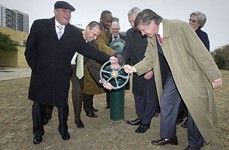Frozen Assets: AWU and the Busted Pipes
Winter weather poses infrastructure challenges
By Richard Whittaker, Fri., Jan. 15, 2010

The weekend's cold snap was a testing time for Austin's water supply. Between the evening of Jan. 8 and the morning of Jan. 11, Austin Water Utility received more than 600 customer calls for broken or frozen pipes, 243 requiring emergency cut-off. But the bigger structural issue was the 45 water main breaks in three days, accounting for almost 10% of what the utility expects in a year. "What we've seen, whenever you have these temperature swings, is this increase in main breaks," said George Calhoun, assistant director of pipeline operations.
The issue is materials. The utility is responsible for 3,631 miles of mains, split between transmission lines (at 16 inches or greater) and smaller distribution pipes. The oldest parts of the system are cast iron, with newer stretches mixing ductile iron pipe and PVC. All these materials have their strengths and weaknesses, but while only about 900 miles – or about 25% – of the system is cast iron, it accounted for 41 of the 45 breaks (about 91%). "It's a more rigid pipe," explained Calhoun, "and it's more susceptible to point pressure and dramatic swings in temperature."
Every year, AWU loses roughly 11% of the water it carries. While some of this can be accounted for by unmetered public projects like road construction and firefighting, the biggest single cause is cracked pipes. Out of the 46 billion gallons supplied to customers in 2007, 3.6 billion (almost 8%) was lost due to leaks. The utility has a detection program and a "prioritized list of replacements," said Calhoun. The utility tracks total usage and local repairs rather than just age. Some stretches of cast iron have served the Downtown area for nearly a century and, if correctly installed by the original engineers, may last another 50 years – longer than some new PVC might last. Nonetheless, due to the higher failure rate, the replacement program is concentrating on those stretches. While urgent, it's also costly, and though Calhoun would like the project completed ideally within 10 years, he said, "Everything that we do is paid for by the funds we get from the water we sell and the wastewater we collect and treat."
In the long run, customers can help extend pipe lifespan with simple conservation techniques. Calhoun said, "It may be the difference of when you're brushing your teeth or you're shaving, you don't just let the water run in the sink."
Got something to say on the subject? Send a letter to the editor.










